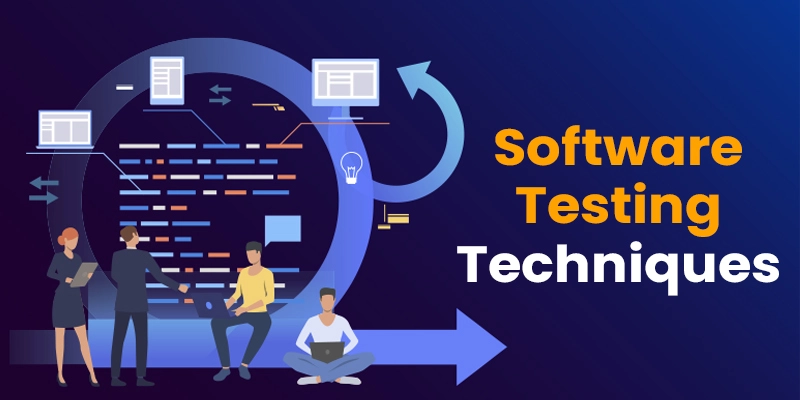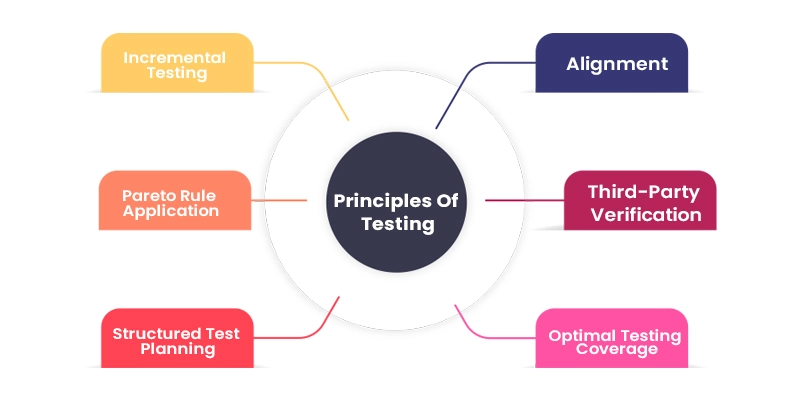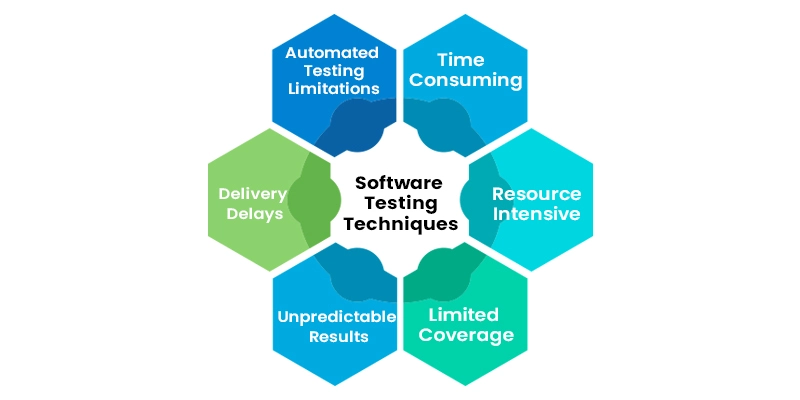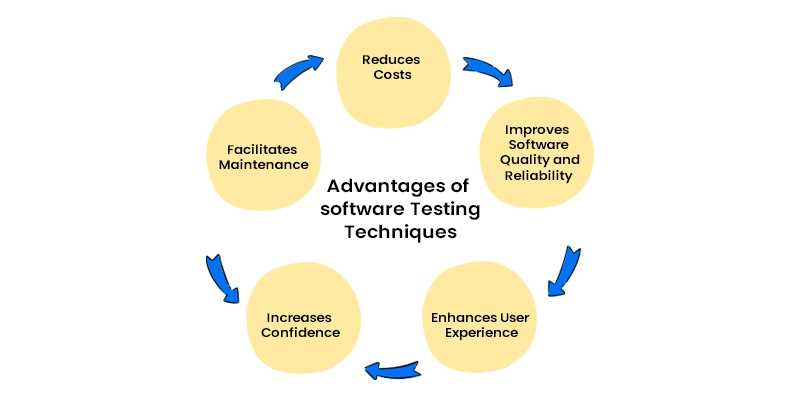
Software testing techniques encompass various methods employed to design and execute tests, evaluating the performance of software applications. Professionals keen on mastering these techniques and contributing to the quality assurance of software development may find value in pursuing a Software Testing Course in Chennai. Such courses can provide comprehensive insights into the latest testing methodologies, tools, and best practices, empowering individuals to enhance their expertise in this critical aspect of the software development lifecycle. The following represent common testing techniques:
- Manual Testing: Involves human testers manually inspecting and evaluating the software.
- Automated Testing: Utilizes software tools to automate the testing process, enhancing efficiency and accuracy.
- Functional Testing: Verifies that the functional requirements of the software align with specified criteria.
- Non-functional Testing: Assesses non-functional aspects such as performance, security, and usability.
- Unit Testing: Examines individual units or components of the software to ensure proper functionality.
- Integration Testing: Validates the integration of diverse components to ensure cohesive system operation.
- System Testing: Tests the entire software system to verify compliance with specified requirements.
- Acceptance Testing: Ensures that the software meets customer or end-user expectations.
- Regression Testing: Examines the software after modifications to prevent the introduction of new defects.
- Performance Testing: Evaluates performance characteristics such as speed, scalability, and stability.
- Security Testing: Identifies vulnerabilities and ensures compliance with security requirements.
- Exploratory Testing: The tester actively explores the software to uncover defects without a predefined test plan.
- Boundary Value Testing: Tests software at input value boundaries to identify potential defects.
- Usability Testing: Assesses user-friendliness and ease of use of the software.
User Acceptance Testing (UAT)
These diverse testing techniques contribute to a comprehensive evaluation of software applications, ensuring reliability, functionality, and user satisfaction. The selection of appropriate techniques depends on the specific goals and characteristics of the software being tested.
Software testing techniques are methodologies employed to assess the application under test against gathered functional or non-functional requirements derived from business objectives. Each testing technique serves the purpose of identifying specific types of defects. It's essential to recognize that techniques designed to uncover structural defects may not effectively pinpoint issues within the end-to-end business flow. Consequently, employing a variety of testing techniques in a testing project is crucial to ensuring a comprehensive evaluation and concluding the project with acceptable quality. The use of multiple techniques helps address diverse aspects of software functionality and performance, contributing to an overall robust testing process. For individuals eager to master these techniques and contribute to the software testing domain, considering a Software Testing Course in Bangalore could be a strategic step toward acquiring in-depth knowledge and practical skills in this dynamic field.
Principles Of Testing

Below are the principles of software testing
Alignment With Customer Requirements
All tests must align with and address the specified requirements of the customer.
Third-Party Verification
software testing methodologies should ideally be performed by an impartial third party to ensure objectivity.
Optimal Testing Coverage
Recognizing the impracticality of exhaustive testing, an optimal level of testing is determined based on risk assessments associated with the application.
Structured Test Planning
Prior to implementation, all tests should be meticulously planned to ensure thorough coverage.
Pareto Rule Application (80/20 Rule)
Adhering to the Pareto Rule, which posits that 80% of errors stem from 20% of program components, guiding a focused testing approach.
Incremental Testing Approach
Commence testing with smaller components before extending the scope to larger ones, facilitating a systematic and efficient testing process.
Types Of Software Testing Techniques

There are two main categories of software testing techniques:
Static Testing Techniques
Static Testing Techniques aim to identify defects in an application without executing the code. This proactive approach is employed to detect errors early in the development cycle, minimizing the cost associated with rectifying issues. By scrutinizing the code and related artifacts, static testing contributes to enhancing the overall quality of the software product.
Dynamic Testing Techniques
Dynamic Testing Techniques focus on evaluating the dynamic behavior of the application through the execution of its code. This involves testing the application with various inputs, including those permitted by requirements (Positive Testing) and those disallowed (Negative Testing). Dynamic testing is instrumental in assessing the actual runtime performance and functionality of the software, providing valuable insights into its behavior under different conditions.
a. Static Testing Techniques
Techniques for testing that don't need a code base to be executed are known as static techniques. Two main types can be distinguished from Static Testing Techniques:
Static Testing Techniques Overview
Static Testing Techniques, which do not necessitate the execution of a code base, are broadly categorized into two main types:
1. Reviews
Reviews encompass a spectrum from informal peer reviews involving two developers or testers discussing artifacts (such as code, test cases, or test data) to more structured inspections led by moderators who may be internal or external to the organization.
- Peer Reviews
Informal reviews occur without a formal setup and involve peers, such as two developers or testers, reviewing each other's artifacts, like code or test cases.
- Walkthroughs
A walkthrough involves the author of the work (code, test case, or document under review) explaining the logic and details to stakeholders, fostering a shared understanding and soliciting feedback.
- Technical Review
This review meeting concentrates exclusively on the technical aspects of the document under review, with a primary focus on achieving consensus. Technical experts, such as architects or chief designers, often conduct these reviews, which can vary in formality.
- Inspection
Inspection represents the most formal category of reviews. Prior to an inspection, the document undergoes thorough preparation. Defects identified during the inspection are logged in a defect management tool and tracked until closure. Discussion on defects is deferred to a separate phase, making inspections highly effective in identifying and addressing issues. For professionals seeking a comprehensive understanding of formal review processes like inspections and aiming to enhance their expertise in software testing, exploring Software Testing Course in Coimbatore could provide valuable insights and hands-on experience in quality assurance methodologies.
2. Static Analysis
Static Analysis involves the examination of requirements, code, or design to identify defects that may or may not lead to failures. For instance, reviewing code against established standards can reveal deviations, which, although not guaranteed to cause failures, are considered defects. Numerous tools for Static Analysis are primarily utilised by developers before or during Component or Integration Testing. The Compiler itself serves as a Static Analysis tool by flagging incorrect syntax usage without executing the code.
Aspects of Code Structure in Static Analysis
- Data Flow
Data Flow pertains to how the data trail is followed in a given program, encompassing how data is accessed and modified based on program instructions. Through Data Flow analysis, defects like unused variable definitions can be identified.
- Control Flow
Control Flow is the structural execution of program instructions, involving conditions, iterations, and loops. Control Flow analysis aids in detecting defects such as Dead Code—code that remains unused under any condition.
- Data Structure
Data Structure refers to the organization of data independent of code. The complexity of data structures contributes to code complexity. Analyzing data structures provides insights into how to test the control flow and data flow within a given codebase. Understanding these aspects enhances the effectiveness of Static Analysis in identifying and addressing potential issues in the early stages of development.
b. Dynamic Testing Techniques
Dynamic testing techniques are categorized into three main groups:
1. Structure-Based Testing
Also known as White Box techniques, Structure-Based Testing focuses on the workings of the code structure and tailors tests accordingly. An essential concept associated with these techniques is code coverage, which is typically applied in Component and Integration Testing.
-
Code Coverage
Code coverage determines the extent to which structural testing techniques cover the total code written. While it is effective in revealing what code is addressed, it has a limitation—it doesn't provide insights into code that has not been written (missed requirements). Tools available in the market assist in measuring code coverage, offering valuable insights into the thoroughness of structural testing techniques.
There are multiple ways to test code coverage
Statement Coverage
Statement coverage is calculated as the number of code statements exercised divided by the total number of statements. For instance, if a code segment comprises 10 lines and a test covers only 5, the statement coverage is 50%.
Decision Coverage
Decision coverage is determined by the number of decision outcomes exercised divided by the total number of decisions. For example, if a code segment has 4 decisions (If conditions) and the test executes only 1, the decision coverage is 25%.
Conditional/Multiple Condition Coverage
Conditional or Multiple Condition Coverage aims to ensure that every possible outcome of each logical condition in a program has been exercised.
2. Experience-Based Techniques
Experience-Based Techniques involve executing methods of testing activities based on accumulated experience over the years. Domain expertise and background play crucial roles in this type of testing. These test case techniques are predominantly employed for User Acceptance Testing (UAT) and business user testing. They complement structured test case techniques like Specification-Based and Structure-Based. Here are the types of experience-based techniques:
-
Error Guessing
Error Guessing is employed by a tester with substantial experience in testing or familiarity with the application under test. Testers use their insights to anticipate potential weaknesses in the system. While not highly effective when used alone, it becomes valuable when combined with structured techniques.
-
Exploratory Testing
Exploratory Testing is a hands-on approach where the objective is to achieve maximum execution coverage with minimal planning. Test design and execution occur simultaneously without documenting test design steps. This testing method emphasizes the tester's understanding of the application's strengths and weaknesses. Similar to error guessing, exploratory testing is most beneficial when employed in conjunction with other formal test case techniques. Check out FITA Academy for more in-depth details related to Exploratory Testing.
3. Specification-Based Techniques
Specification-based techniques involve both functional and non-functional approaches, addressing quality characteristics. It entails creating and executing tests based on functional or non-functional specifications from the business. The primary focus is on identifying defects corresponding to given specifications. Here are the types of specification-based techniques:
-
Equivalence Partitioning
Equivalence Partitioning is a technique that is often used in conjunction with various levels of methods of testing. The primary concept involves dividing the input data range into valid and non-valid sections, identifying one partition as "equivalent." Testing only requires selecting any value within a partition, assuming that all values in the partition will exhibit similar behavior. For instance, if an input field accepts values between 1 and 999, testing with any value within this range is deemed sufficient, as the behavior is expected to be consistent for all values in the partition.
-
Boundary Value Analysis (BVA)
Boundary Value Analysis tests the boundaries of a range, both valid and invalid. In the given example, testing the boundaries 0, 1, 999, and 1000 is crucial. This type of testing is based on the assumption that boundaries are often not handled gracefully in the code.
-
Decision Tables
Decision Tables, also known as Cause-Effect tables, are effective for testing combinations of inputs. Conditions applicable to the application segment under test are structured in a table, with outcomes identified for each condition. It aids in reaching effective tests without an overwhelming number of combinations. For instance, a decision table can be used to define the conditions for issuing a credit card based on credit score and salary limit.
-
Use Case-Based Testing
Use Case-Based Testing involves identifying test cases that execute the system as a whole, simulating user interactions and transactions. Use cases describe the sequence of steps that detail the interaction between the actor (user) and the system. This testing method is particularly effective in identifying integration defects. Use cases also define preconditions and postconditions of the process flow, providing a comprehensive understanding of system behavior.
-
State Transition Testing
State Transition Testing is applicable when the application or a part of it can be treated as a Finite State Machine (FSM). For example, in the simplified ATM example, the ATM flow can be considered to have finite states, making it suitable for state transition testing. The key considerations include defining states the system can achieve, events causing state changes, transitions between states, and outcomes of state changes. A state-event pair table is created to derive positive and negative test conditions.
Advantages Of Software Testing Techniques

Improves Software Quality And Reliability
Different methods of testing allow software developers to detect and rectify defects early in the development process. This proactive approach reduces the risk of failure or unexpected behaviour in the final product, contributing to enhanced software quality and reliability.
Enhances User Experience
Techniques such as usability testing play a crucial role in identifying and addressing usability issues, ultimately improving the overall user experience. This user-centric testing ensures that the software is not only functional but also user-friendly and intuitive. For those aspiring to delve deeper into user-centric testing methodologies and enhance their proficiency in software testing, consider enrolling in a comprehensive Software Testing Course in Madurai. This educational opportunity will provide you with valuable skills and knowledge to contribute effectively to the creation of software that aligns seamlessly with user needs and expectations.
Increases Confidence
Testing provides developers and stakeholders with the confidence that the software meets specified requirements and functions as intended. The thorough examination of the software's performance instills trust in its reliability and adherence to expectations.
Facilitates Maintenance
Early identification and resolution of defects through testing make it easier to maintain and update the software. Maintenance activities become more streamlined when potential issues are addressed proactively during the development phase.
Reduces Costs
Detecting and fixing defects in the early stages of development is more cost-effective than addressing them later in the software life cycle. Testing plays a crucial role in cost reduction by minimizing the impact of defects and avoiding costly fixes in the later stages of development or post-release.
Disadvantages of Software Testing Methodologies
Time-Consuming
Testing can be time-consuming, especially when thorough testing is performed to ensure comprehensive coverage. The duration of methods of testing can impact the overall development timeline.
Resource-Intensive
Testing demands specialised skills and resources, which can be costly. Acquiring and maintaining the necessary testing expertise, tools, and infrastructure can contribute to resource-intensive processes.
Limited Coverage
Testing can only reveal defects that are present in the defined test cases. As a result, there is a possibility of overlooking defects that may exist outside the scope of the test cases, leading to limited defect coverage.
Unpredictable Results
The outcome of methods of testing is not always predictable, and defects can be challenging to replicate and fix. Unpredictable results may require additional effort to identify and address unexpected issues.
Delivery Delays
Testing, especially if it takes longer than anticipated or if significant defects are discovered, can lead to delays in software delivery. Managing testing timelines is crucial to avoiding project delays.
Automated Testing Limitations
Automated testing tools may have limitations, making it challenging to test certain aspects of the software. Additionally, automated tests may require substantial maintenance and updates to remain effective and aligned with changes in the software. For those eager to navigate the complexities of automated methods of testing and stay abreast of evolving methodologies, consider enrolling in a comprehensive Software Testing Course in Trichy. This educational endeavor will equip you with the skills needed to effectively address automated methods of testing challenges and contribute to software quality assurance's ongoing success.
